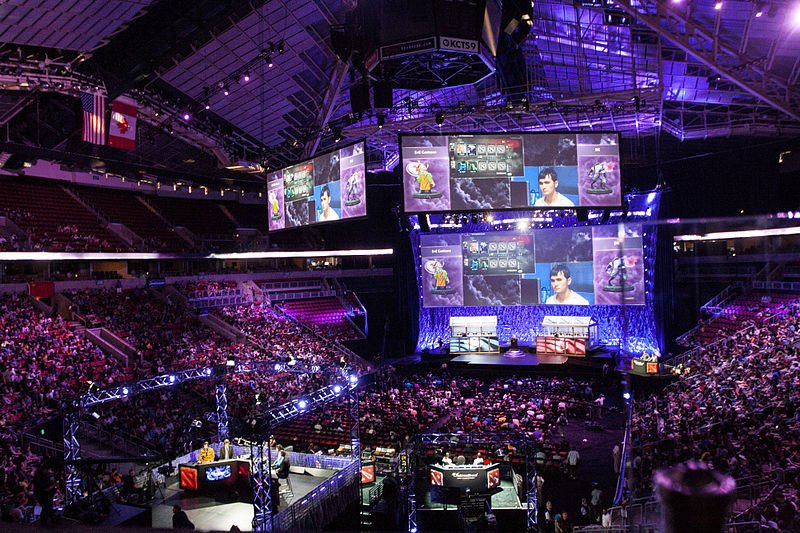eSports - The World's Next Sport
You Want to do What With Your Life?
If you tell your parents you plan on being a professional eSports gamer, they might very well look at you with that worried expression only parents know how to give. But what if you told them that many eSports professionals can get paid a million dollars just to play? Now that they’re listening, you might also consider telling them that some schools are allowing eSports gamers in on scholarship, too.
So much for having to run around outside chasing a ball to get that opportunity!
When it comes to one of the biggest, world-wide spectator sports, eSports really takes the cake. And I’m not lying about the cake, either. You’ll see below just how much these players can walk away with.
With millions of spectators for tournaments and events, there’s no question that eSports is gaining a whole lot of traction as a legitimate, professional sport.
The Lore Behind eSports

In the early 1970’s, the very first video game tournament was held. Played on archaic computers (that were the cream of the crop at the time), gamers battled for supremacy in Spacewar!, a space combat game developed in 1962.
After that, video game competitions generally took place in front of an arcade cabinet, the winner being the one with the highest score. Spectators would inevitably gather to watch the competitions, essentially making video games a spectator sport for decades.
Just as video games have evolved immensely since that first historic battle for galactic conquest, the competitive nature of the hobby has likewise expanded beyond anything those in the 1970’s could have imagined.
Although gamers have been procuring a living off their skills since the late 1990’s, the professionalism of eSports as we know it began taking off around 2010 with the release of Blizzard’s Star Craft II. Since then, professional gaming has become not only a way to make an obscene amount of money, but has also evolved into a massively popular spectator sport.

Today we see massive stadiums packed with fans, watching their favorite video games be played by their favorite players - all for high stakes. The atmosphere is much like that of a traditional sporting event – thousands of fans, lots of cheering, and edge-of-the-seat action.
And if you can’t make it to the stadium, you can be like millions of others and watch all the action live from your home computer screen. Some places even rent out movie theaters for fans to watch in.
While you might think professional gaming is all just fun and games (and you wouldn’t be wrong), there’s a lot more to it than just sitting down to play. Just like other professional sports, it takes time, commitment, and hours upon hours of practice to be the best in eSports. But there’s also the players’ health to consider, as well as the equipment needed to train.
Just like any sport, there’s a lot that goes on that most spectators don’t see.
Health
In many video games, one thing you don’t want to do is die. Dying is bad. So, in order to not die, players will do what they can to keep their character in good health. Stim packs, healing spells, and cutting grass in hopes of finding an extra heart are all things we’ve done to keep our character as healthy as possible.
For those heavily involved in eSports, their personal health can diminish almost as quickly as a level 6 Wukong being pummeled by a level 15 Cho’Gath (curse him, anyway). In fact, ESPN suggests that professional eSports players have one of the shortest careers around, due in part to the intense lifestyle and long hours of practice.
They certainly give it all they’ve got.
While perhaps not the most physically fit of athletes (except for maybe baseball players), eSport professionals must be in tip-top shape when it comes to mental fitness. ESPN reports on at least one League of Legends team practicing 12 hours a day with only a day or two off each month. Being mentally fit is crucial if these gamers play this intensely for long periods of time.
Speaking of fitness, the life of an eSports professional can be very sedentary. If you’re like that League of Legends team and practicing for 12 hours a day, you’re in for a lot of sitting and not much moving. And with that much practice, what about eating? Many players can attest that while engaging in long spurts of gaming, their food choices may not be the healthiest, as well as being inclined to over eating when they do get a chance. However, unlike a traditional athlete, who must train their body for their particular sport, eSports athletes don’t have to engage in rigorous exercise to be at the top of their game.
You’ve probably heard the expression “too much of a good thing,” and that applies to playing video games as much as it does on grinding away at lower-level minions. After a certain point, it’s just painful. Too many hours playing video games can aggravate the body and lead to a host of physical problems. Truly, the life of an athlete is full of difficulties. Of course – just like any sport – there are ways to avoid these health hazards. Before you strain yourself too much, make sure you set aside some time to take care of physical and mental needs.
eSports Gear
If you want to compete with the best, you need to gear up. While you may be fine for a little while with a slower computer model, that might not be good enough for long. In order to keep up with the competition (quite literally), your computer needs to be fast enough that it won’t lag out during a crucial moment in the game. Getting killed because your computer wasn’t fast enough isn’t going to go over well with your teammates.
Now that your software is speedy fast, there are other things to consider. Don’t forget that special controller or keyboard, mouse, and headset to give you the advantage where quick fingers and a clear line of communications can be the difference between victory and defeat.
That’s just the gear you need to actually compete in eSports. If you want to get noticed, you’ll have to find ways for people to watch you dominate the competition. Streaming your games live – or uploading them after the fact – is one way to get your name out there. That means you’ll need even more equipment to capture your game footage and send it to a streaming site, like Twitch.
Just like any sport, getting started means getting gear.
What the Pros are Playing
Most athletes don’t have to relearn their sport every few years to keep competing. Can you imagine a basketball player trying to pick up football three years into his career just so he can remain the best? That’s just ridiculous!
But that’s exactly how it is with eSports. When new games are released, pro players need to master it quickly. There are many games, however, that don’t change too terribly much as the years go by. All in all, it just depends on the game.
Just as each game differs in play style, they can vary just as much in what you can get back from it. Some games will have a higher payout in tournaments than others, so if you’re looking to go big, you might want to keep that in mind.
And the payouts at these tournaments can be off-the-wall insane.
In 2015, DOTA 2 shelled out an astonishing $18 million reward to the winners. The next highest prize was just over $2.5 million for Smite, followed closely by League of Legends at $2.1 million. The Call of Duty World Championship rewarded its winners with “only” $1 million. As you can see, there’s some good money to be made by playing video games. So the next time somebody says you’re wasting your time in front of a screen, just throw these numbers at them.
While DOTA 2 may give the highest payout, League of Legends looks to be the most popular in terms of fan base. DOTA isn’t far behind in popularity, however, and other games like Counter Strike and Starcraft really give eSports a unique variety of genres and gameplay.
What’s Next for eSports
With spectatorship growing faster than Sonic can collect gold rings, along with insane amount of prize money to be won in competitions, eSports will be the sport that continues to change. For instance, as virtual reality becomes more mainstream, it’s possible more gaming titles will veer in that direction, potentially allowing for new additions in the eSports format.
Much like the world these gamers play in, things change quickly, and if they don’t adapt, they simply won’t win. The same goes with eSports as a whole. Change is constant. And, with a high turnover rate and new games being continually released, it’s difficult to predict what might become of eSports.
One thing is for certain, however – eSports are here, and they’re here to stay. It’s what they will evolve into in the future that we look forward to with great interest.
Jordan Knight is the vice president of eSports at Stimpack. He loves competitive gaming and helping competitors reach their peak performance. He remains committed to the community and has had success both in-game and outside of gaming.
All Content